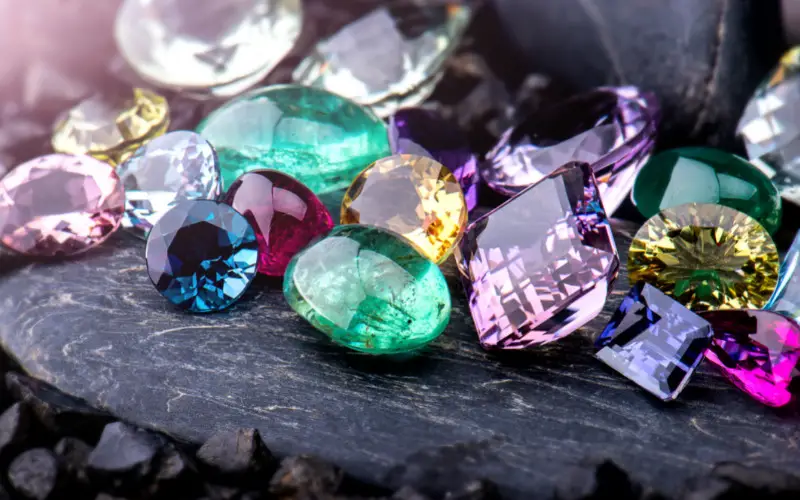Gemstone exploration is a business that has been in existence since historic times, and it is a trade that is growing in leaps and bounds with a market value of over $23 billion. Little wonder everyone is looking for gemstones in their backyards.
Diamonds, Rubies, Emeralds, and Sapphire are the most valuable because precious gemstones are rare and expensive.
So, people are looking for alternatives, which is why gemstones exploration is a business that is always on the rise.
Even though some of these other gemstones are not as pricy as the ‘big four, they fetch ‘something’ substantial in the market because they have aesthetic value; some even say they have psychic, emotional and spiritual benefits. And as usual, we will stick to what we can prove scientifically.
List Of Common Gems That Can Be Found in Your Backyard
There are a lot of gems that can be found anywhere, your backyard inclusive; however, these listed below are the most common:
1. Quartz
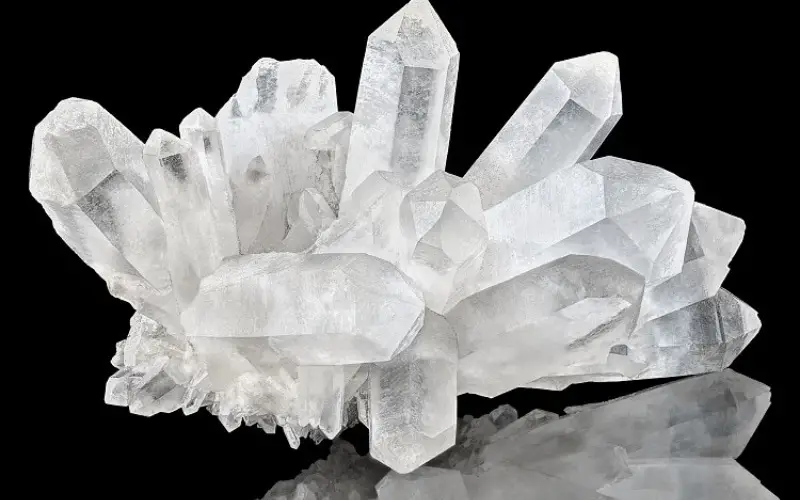
this is a mineral material that you can find easily, even on your topsoil. Maybe you have not found any yet because you are not searching and because it doesn’t look any different in its raw form from other rocks.
This rock can contain other gemstones like Amethyst, Citrine, Ametrine and others. Quartz is colorless, transparent, and very hard crystal with a lustre like glass in its pure form.
If you see a gemstone like quartz and want to be doubly sure, just scratch the stone with a blade and if it doesn’t peel, then you have quartz in your hand because it is very strong.
Because of its strength, it is used as abrasives, and foundry materials, for making cement and ceramics.
Quartz is piezoelectric, which means it can convert mechanical energy to electrical energy and is used in making electronics.
Its highly transparent nature makes it a good material for making jewelry, ornamental and other home decors. Quartz is mined in most parts of the globe, especially in Brazil and Madagascar.
2. Agate
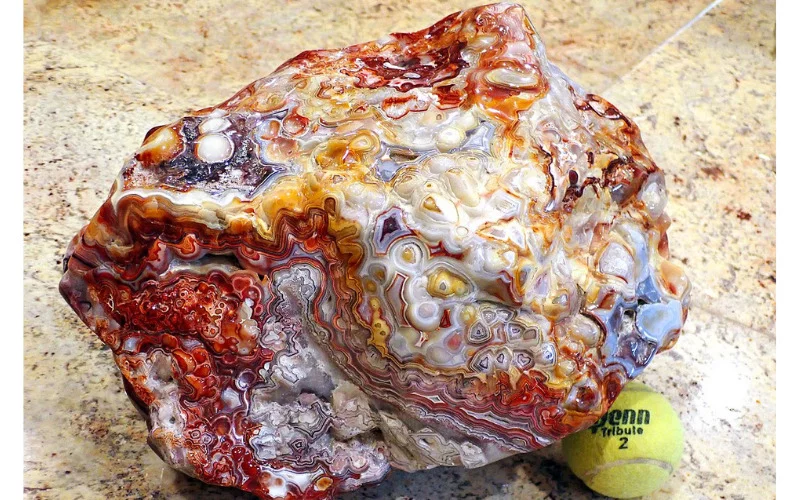
This beautiful gemstone, which is usually brown or reddish, can also have a green hue.
They can be found near lava beds, and when you hold them up to artificial light, you will notice them as a brownish-red gemstone that is semi-translucent that may or may not have some stripping or banding.
They are used mostly used for making rings, earrings and other jewelry and ornamental products.
3. Garnet
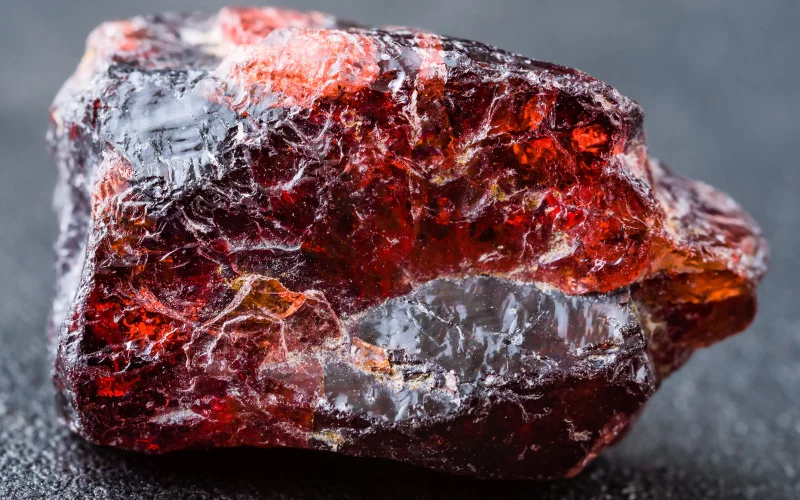
These stones are usually dark red but have others that are black, pink, yellow, and orange. They come as almandines, rhodolite and pyrope; in fact, the red pyrope has a very high market value.
This gemstone is relatively affordable and popular; it is also hard, and so it is used as an abrasive for cutting metals.
They are commonly mined in many countries, especially in the US states of Idaho, Arizona, North Carolina, Utah, Montana, amongst others.
4. Jade
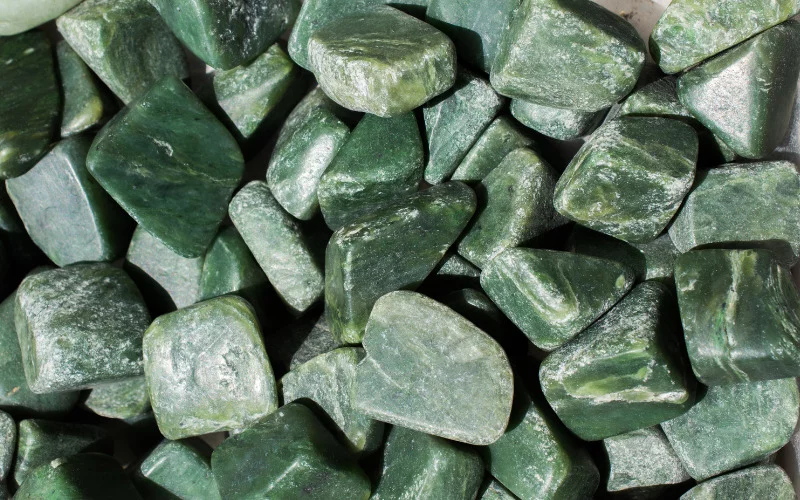
These magnificent gemstones are mostly green in color, but some are white and even purple. They are mined mostly for making jewelry, beads, and sculptures.
They are found in many places, including Russia, China, Canada, British Columb, Guatemala and in California, Wyoming, and Washington in the US.
These stones are usually smooth and cold when they are held. The Imperial jade is the best quality of these gemstones because of its matt, mint green color.
5. Opal
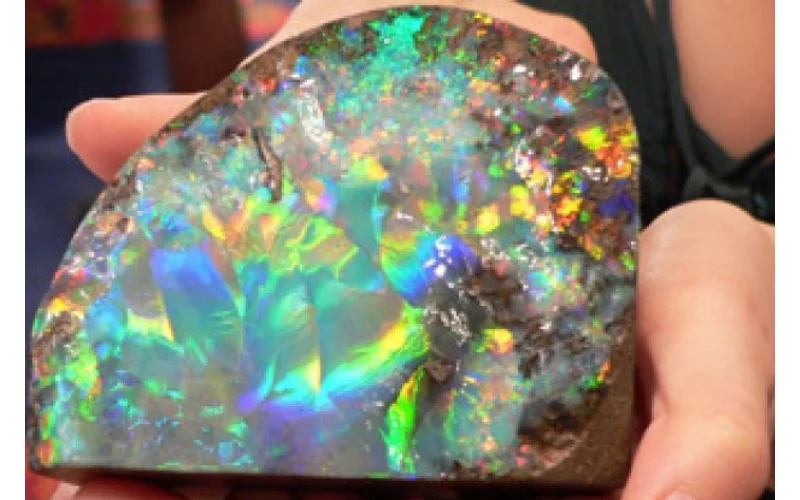
The black opal is the most valuable gemstone with other hues like pink, brown, purple, and green. There are also the white opal and the fire opal, which are most common. Oregon, Nevada, Idaho and California and other countries like Australia have a reasonable mineral deposit.
Opal is famous for its glimmering color; they are opalescent: meaning that they show a rainbow iridescence. Most opals come in different shapes and are smooth in appearance.
Premium quality opals are the Rainbow opal that can reflect all the colors of a spectrum as they are held to alight.
6. Topaz
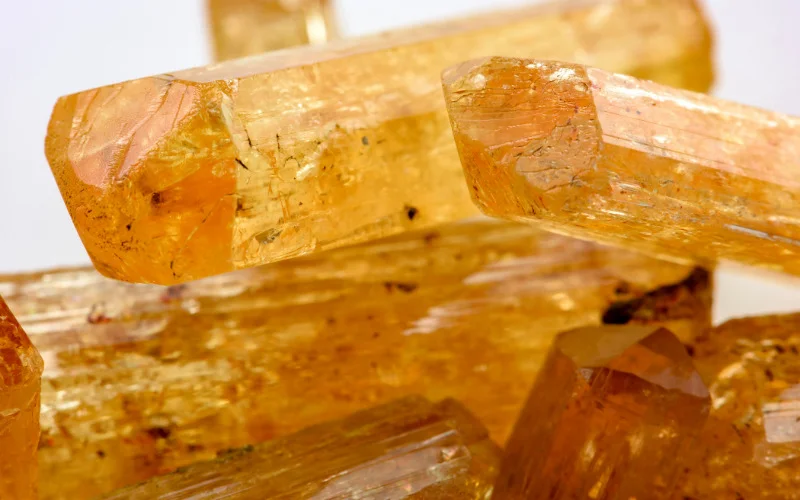
These gemstones are very hard naturally and are found mostly in streams. They are used in making jewelry.
Even though they are not very expensive, they are still loved by many jewelers and gemstone collectors.
Topaz contains many impurities that can mar its colors, which is why it is carefully cleaned. Texas, Mexico, Central Europe, and Asia are hot spots for mining it.
7. Turquoise
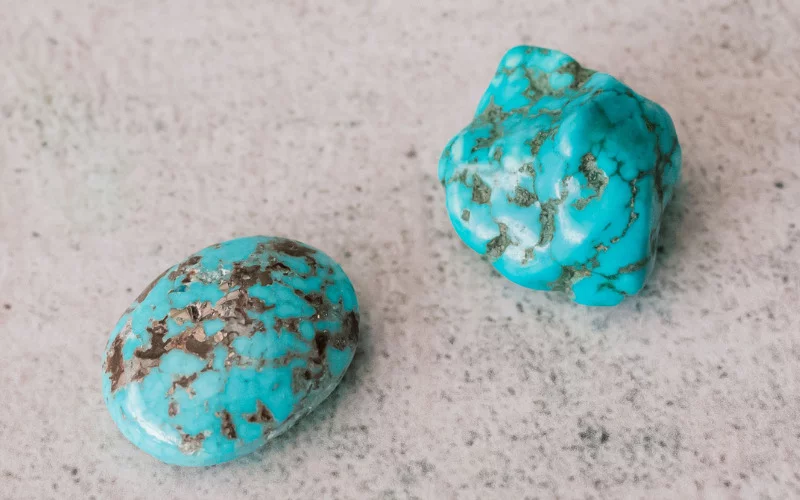
These stones, which are mined in the southwestern states of the US, including Colorado, Nevada, Arizona and in other countries like Egypt, Mexico, and Iran, are used in making tools, pottery, sculpture even for designing clothes.
They are porous stones and must only be cleaned with water, not exposed to too much sunlight, and stored properly.
Most Turquoise has a webbing in them that distinguishes them. The lavender blue Turquoise is the best and rarest of these gemstones.
8. Tourmaline
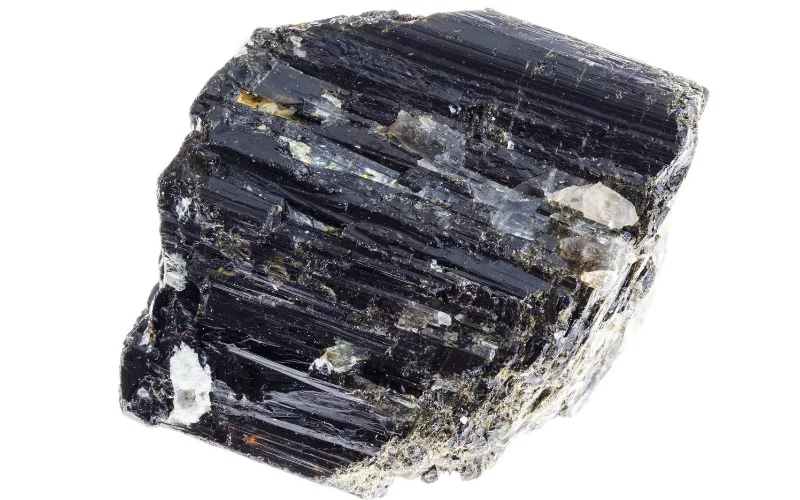
Tourmaline comes in various colors like deep blue, strong green, black and yellow. They are distinguished by the fact that they don’t change color when they are held under light. They are valuable as jewelries and ornamental objects.
RECOMMENDED: How To Find Amethyst in Your Backyard
Where Are Gemstones Mostly Found?
There are many places where these gemstones exist in nature, and these places include all kinds of rock, be they rock geodes, igneous, metamorphic, and even sedimentary rocks; you have them to dig to get some.
Tools Used for Prospecting for Gemstones
When you go prospecting for gemstones, there are essential tools and materials that you must carry if your venture is to be a fruitful one.
Just as there are different methods for mining these gemstones, different tools are also needed for each method.
Some of these tools and materials are readily available; however, you will have to rent from a geological shop. Below are some of the basic tools you will need when you go in search of gemstones:
1. Geological pick: this instrument has other geological uses for documenting and photographing a specimen you are exploring. It can also be used to chip off small pieces of rocks when you are prospecting for gemstones.
2. Crack hammer: these are very heavy hammers that come in 3 and 4-pound versions. As you pick one to go mining a gemstone, ensure that you pick one that you are comfortable with because prospecting for gemstones can be quite tasking, and you don’t want to work with a tool that will tire you out.
The size of hammer you use will depend on the material you want to break: the bigger the rock specimen, the bigger the hammer you need if it must be done effectively.
3. Pry bar: This tool is used to dismantle boulders, pick up specimens you want to work on, and search dumps.
4. Altimeter: This works like a GPS but is much more effective for gemstone mining because it helps you find your way, especially at high altitudes.
5. Backpack: The internal back park is useful in carrying your prospecting tools and personal effects. Carrying tools in a bucket is burdensome if you are walking up a slope or climbing a mountain.
This backpack has the advantage of transferring the weight you are carrying away from the shoulder; hence you don’t feel the heaviness.
The backpack should not be bigger than your body so that it doesn’t get caught in a tree branch if you move in the woods. You can put your bucket inside the back park if you need it.
6. Chisels: a carbide-tipped chisel is a good tool for breaking through rocks. The hand point chisel is a type of chisel useful in breaking rocks in a controlled manner.
When using a carbide tip chisel, be very cautious because though they are hard, they can be brittle if care is not taken.
Painting your chisel, a brilliant color, might prove useful if you are working on a rock of the same color as your chisel so that when the chisel drops, you will not have difficulty finding it.
7. Brushes: if you noticed, we didn’t say brush; this is because you will need more than one type of brush for different purposes.
A heavy-duty paintbrush can brush hard gemstones covered in dirt and sand, while other light or fine brushes can be used to brush softer gemstones. These brushes can also be used to keep the work area clean.
8. Sledgehammer: different types of hammers are used in gemstones mining. However, the short handle sledgehammer is better because it has increased accuracy, is easy to lift and swing and quite useful when working on odd angles.
9. Pocket tools: You will find other tools useful in your expedition like screwdrivers, ice picks, coat hangers, and others.
10. Saw: sometimes, you want to extract a crystal specimen from a broad rock face without damaging it, and in this case, a saw comes in handy.
11. Screen: this tool is to you what a strainer is to a chef. Screens are like a strainer that you use in straining the gemstone ore so that the water and sand are strained out, and the stones remain.
Other tools include buckets, plastic bags, hand shovels, folding shovels, pickaxes: pan and minicabs. Other personal effects would come in handy, including:
- A sunblock: you will need to protect your skin from the ultraviolet rays of the sun as you work for hours outside.
- Insect repellent: if you work near water bodies, you will want to protect yourself from mosquito bites.
- Proper clothing: when you go for gemstone exploration, you need to be as comfortable as ever, so you must wear the right clothes that you are comfortable in and keep your body protected from insects.
- Polarized sunglasses: this is an important item you need in your exploration bag because it will reduce the reflection of surfaces and allow you to see the true color of the gemstone amongst all that sand and dirt.
Methods For Exploring Gemstones
The methods used in prospecting for gemstones all through historic times have seen little change in most mining areas. Many explorers still use the same old methods in the world.
Most of the gemstone mining in the world is done by many subsistence miners who cannot afford or refuse to go for an innovative method of prospecting for these stones, which means their operation is based on sheer luck and experience.
There are many innovative methods that professionals use for prospecting gemstones. They include trace elements analysis, high x-ray frequency, amongst others, and each of them has its pros and cons.
There is a rather innovative way of exploring gemstones that are becoming popular, and it is the GPR method.
Ground-penetrating radar GPR is an exploring method. A device known as the Terra Thumper scans the ground, searching for elements that indicate what gemstone deposit can be underneath the ground.
This is done by identifying the difference in the rock structure by a means known as seismic analysis.
This method is expensive but, by and large, yield a better result than depending on sheer luck. You can use this method to determine where to start digging for these gemstones.
This innovative technique is not meant to replace the traditional exploration method but can be used to complement these other methods
The Traditional Ways for Exploring Gemstones Include
1. Sluicing:
this is the method used in prospecting for gemstones in waterways or running water. In this method, you sit before a flume or a sluicing way, and then you scoop some ore that you suspect might have some gemstones.
You then wash them so that the dirt is removed and only the stones are left behind. You can now scan through the stones to see which ones are valuable.
You might need an assistant or a gemologist to identify which stone is and how valuable they are.
This might take a while, so be as comfortable as possible; you can get a cushion to make you more comfortable as your seat.
Gloves and warm clothing should be worn on cold days too. You can scoop a lot of ore and then carry them to a comfortable place to wash.
2. Panning:
This is also known as creaking, and this is because it is used for mining in creeks. These creeks can be so deep, and so you must be very careful.
Here you peer at the gravels and rocks to see if there are embedded gemstones in them. Some people use a hand shovel and a screen to explore.
Shovels are used to dig ore and then poured into the screen so that the water and sand are strained away while the stones are left on the screen. You can scrutinize to see which gem is what.
3. Digging:
Diggers are used to cut into the mine’s vein or ground to look for the gemstone. This is used in prospecting for gemstones from rocks and thus can be very tedious and time-consuming.
After You Have Found Your Gemstone
We cannot explain that feeling you have when you are done with your digging and excavation, and now you are ready to analyze what your effort for all those hours or maybe even days of hard work truly yielded, at this moment, the next thing to do is to clean your ‘loot’.
Cleaning Of Your Gemstones
The gemstones you have just hauled in is in their raw state might look a little disappointing to a bystander or even you because you see stones that are not too different from pebbles all around you; they may look dull and rough with a lot of dirt around it. The next thing you do is clean your stones.
Each gemstone is unique in its mineral composition and hardness, and these determine how you clean your stones.
The idea is to remove all the dirt and other obstructions in your gemstones without damaging them.
Below are some tips and ways of cleaning your gemstones:
- The hardness of a gemstone will determine the method you will use to clean them. For example, as a rule of thumb, no gemstone with a Moh’s scale of less than 5 should be cleaned abrasively.
- With a hard brush, all soft gemstones will be damaged by abrasive cleaning, so you might want to steer clear of these hard tools.
- Dish soap and a scrub brush can clean these stones over running water or in a bucket.
- Nylon or toothbrush can help get the dirt at smaller spots
- A dental probe can pick out muds or dirt from pockets and holes in the stones.
- Steer clear of steel material, especially when working on soft gemstones; instead, go for brass brushes if you must.
- Sandblasting can be used to clean hard stones with many obstructions. Glass beads can be used in this method.
- Air scribes: this tool can be used to clean large material, and it comprises a tiny pneumatic chisel with air compression.
- Spot cleaning guns which are used for cleaning clothing can be used to clean gemstones if the spray pressure is increased
- many household items can be used to clean gemstones like vinegar, but caution must be exercised.
- Some gemstones are so delicate that they should only be cleaned with only water.
Identification of Gemstones
As a novice in the business, you might require a professional’s help to help you identify the different stones that you have collected.
The colors of gemstones are the first distinguishing factors and so knowing the colors of this individual gemstone is the first step to identifying them.
There are other identifying factors like the hardness of each stone detected by its Moh’s scale value.
Your best option is to seek the help of an expert to identify what you have so you can get the real value of your stones.
Appraising And Selling Your Gemstones
This is the main reason for all that harrowing work you put yourself through.
Appraisal of a Gemstone
A professional or gemologist can appraise and tell you not only the value of your stones but other information like its geological description, including its carat, cut, clarity, color, size and weight.
Selling Your Gemstone
The amount your gemstone will fetch in the market will depend on the 4 Cs that is used in gemology, and they are:
- Gemstone cut: gemstones can be treated to enhance the money they fetch by fracture filling, diffusion, heating, and drilling. So, a beautifully cut gemstone will net you more cash than one with an odd-looking cut. The standard cuts of most gemstones are oval cut, pear cut, emerald cut, amongst others. When a gemstone is well cut and has fewer inclusions with brilliant color, they sell for a higher price.
- Clarity: the inclusion in gemstone tells you that they are not synthetic; the paler the color of these stones, the more inclusions there are, the less the amount you will get for them. So, if you want to get more money for your gemstone, ensure that you take care of all obstructions in it.
- Gemstone color: every gemstone has colors that they are known for, and they all have a different value when they come in a given color. So, if you pick a gemstone whose color is bright or one associated with the given some, you will fetch more cash for it. For instance, the red pyrope is valuable just because it is a red garnet.
- Carat weight: The higher the carat weight of a gemstone, the more money it will fetch you in the market.
Conclusion
The fact that gemstone prospecting is very lucrative is no longer in doubt; what is most exhilarating is that you can become a prospector yourself and where best to start if not your backyard.
Many gemstones are in and on your ground, and you most times overlook them. It’s like overlooking a gold mine.
There are a wide variety of these stones anywhere; if you are keen enough to search and persist, you will see yourself smiling at the bank.
You May Also Like:
- Can I Find Amethyst in My Backyard? – YES, You Can!
- 5 Best Chairs For Soccer Games For Comfort
- What Are the Possible Causes of Pond Leakage?
- How To Install a Basketball Hoop on A Garage Wall or House?
Hope this article helped you learn how to find gemstones in your backyard. You may also want to bookmark our article on How To Find Amethyst in Your Backyard.
I will love to hear from you if you have any other suggestions on how to find gemstones in your backyard, all you have to do is comment below and reach out to people by sharing this post on social media.
If you liked this article, then please follow us on Facebook, Instagram, and Pinterest.

